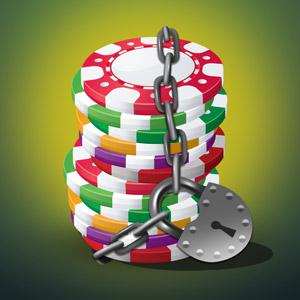People visit casinos for a variety of reasons. Some are city locals who simply enjoy people watching in their spare time. Many others relish the atmosphere of luxury and risk that seems to be universal at casino establishments all around the world. A good number of casino goers are enthusiastic, seasoned gambling vets. But many of the people you’ll see at a given casino are new. But they all encounter casino chips at some point.
These casino guests are curious, occasionally cautious, but always intrigued. They recognize the scene. It all comes together so smoothly. The wide spread of flashing machines, the courteous wait staff ready to help, calls for last bets in roulette, and, of course, the clinking of the chips.
Gaming chips, casino tokens, poker chips – these are essentially the same object that goes by different names. They’re an icon of the traditional brick and mortar casino. Regardless of what you usually call them, they’re one of the many charming aspects of gambling. Today it’s just about impossible to step foot into any given casino without spotting poker chips somewhere.
Casino chips are in use for practically all of the games. From blackjack to roulette, poker to craps, they also appear in the casino’s promotional advertisements. And they are often used in lieu of regular currency, for example when tipping casino service staff. Let’s take a look back at where and how these beloved, often magic tokens got their start
History
B.C.: “Before Chips”
The human urge to play games of risk predates written history. Evidence of gambling dates all the way back to the Paleolithic period. The very first discovery of a six-sided die occurred in Mesopotamia. The die dates back to approximately 3000 B.C. These dice are so ancient that they were based on the now-obsolete system of astragalomancy, a form of divination with special marks consisting of letters and numbers, dating back thousands of years earlier.
Around 2300 B.C., the Chinese invented a separate game of chance using tiles. Their most popular gambling game today? Another tile-based game you might have heard of is mahjong. This is a game that can be tricky to learn as it depends on basic knowledge of Chinese characters and even trickier to improve at.
Then, more than one thousand years later, in Greece, the soldiers would amuse themselves by playing dice games against each other, in spite of the fact that gambling in general was illegal in ancient Greece.
Poker is perhaps the most well-known of today’s casino games that’s associated with the use of these tokens – hence the name poker chips. This card game is based on a game called As-Nas, which originated in 17th-century Persia.
The Predecessor of Today’s Casino Token
Our predisposition to gamble is an inherently human activity that goes back before recorded history. But it wasn’t always as standardized an industry as it is today. Established in Venice in 1638, the Ridotto is believed to be the first European casino. Although it was closed in 1774, casinos began to rise in popularity not long after, spreading all over the world and continuing to develop in this day and age.
Although casinos themselves became more common, casino chips didn’t always exist. The counters that most resembled modern casino chips as a concept were used to keep score in the card game Ombre, which originated in Spain, as well as an eighteenth-century variant called Quadrille.
In the year 1752, French Quadrille sets contained counters known as jettons, fiches and mils. Unlike the poker chips of today, their colors did not mark the monetary value of the individual chip but rather indicated player ownership. This was to facilitate the process of dealing with separate payouts for multiple players at the conclusion of each game. Instead of today’s conventional circular shape, these counters indicated denominations through the different shapes of each type.
As gambling became more and more common in the United States, bets were placed with many valuable objects. Coins were accepted of course, but it was also normal to place wagers with gold dust or gold nuggets. The most significant in the evolution of casino tokens? 19th-century gamblers began to use “chips” fashioned out of materials like ivory, bone, wood, and clay.
Standardization
The game rules, establishments, and laws surrounding gambling have become much more sophisticated over time. In the late 1800s, companies had already begun to standardize the betting system, mostly by manufacturing clay composition poker chips. The dominant colors at the time were red, yellow, white, and blue.
Black, green, and, in some cases, pink have since joined the most commonly used colors in the United States. $1 chips are typically white or blue, $5 chips are red, $25 chips are green or yellow, $50 chips are blue, and $100 chips are either black or white. Pink chips are less common and are usually worth $2.50.
Regulation of chips was a natural development for obvious reasons. As casinos became a highly lucrative business, it became more and more important to have a trustworthy way to keep track of bets. After all, the human impulse to cheat or take advantage of others in order to win stretches back just as far as the age-old attraction of simply playing these games of chance themselves. For that reason, unified establishment of a credible currency became a necessity.
Casino chips are casino currency
Countries rely heavily on a complex, difficult-to-duplicate currency to ensure that the economy runs smoothly and that consumers’ security is maintained. Casino chips are the currency of the “world” of each individual casino, what makes the system run efficiently.
To create authentic chips, companies had to come up with innovative designs that were difficult to replicate. Just as there are many security features added regularly to real, paper money, chips needed to have complex and unique designs.
This also requires more and more new versions to ensure that the chips keep up with technological advancements. Many people who don’t necessarily play at casinos have become collectors, and there are now online sources that help people identify chips by state, city, casino type, casino name, and denomination.
The chips also serve another significant function: they put the players’ minds at ease. They’ve exchanged their cash for chips, and they want to be free to play without inhibitions. Having a set of colorful tokens in front of you allows you to play without getting caught up in your head about how much money you might lose. You don’t want to play with a mental burden that can cause you to second guess yourself.
Construction
Nearly all tokens contain clay, like in the beginning. Otherwise, they consist of a material like sand or chalk or are made of ceramic. There are typically pieces on the edges where the material is removed and material of a different color is inserted. Chips also often contain an inlay, the graphics that are embedded into the center of the chip. The final step in construction is a heated compression process that binds everything together and molds the chip into its final shape.
It’s difficult to find more detailed information about how chips are made. Each chip manufacturer has its own ways of creating a unique effect. This also varies from casino to casino. But dispensing that information would make it easier for players to create counterfeit tokens.
The chips have features like custom colors, UV markings, high-resolution art, and sometimes even RFID technology. This combination, as well as casino staff’s acute familiarity with the chips’ tiniest details, prove successful in preventing counterfeiting in most cases.
Drawbacks
Of course, no system is perfect. There have been some inevitable hiccups that occur with widespread systems where money is involved, particularly with counterfeiting. Whenever it comes to winning money, there are always those who will try to beat the system.
One such incident occurred in January of 2014, at the Borgata Hotel Casino and Spa in Atlantic City. The casino was holding its regular Winter Poker Open as scheduled. Everything appeared to be going exactly as planned. The tournament was well underway, down to only twenty-seven remaining players out of an original 4,814 players, all of whom had paid a buy-in of $560.
Counterfeit casino chips
Suddenly, the unthinkable happened. Tournament officials discovered that the $2 million guaranteed opening event may have been compromised by counterfeit chips. After an investigation, the New Jersey Division of Gaming Enforcement determined that the damage caused by the fake chips was too extensive. It could not be undone. At that point, the casino was forced to cancel the tournament. This was a devastating development for the remaining players who were competing for a top prize of $372,123.
At the time, Borgata’s president and chief operating officer Tom Ballance released a statement. In it, he explained that counterfeit chips had been used, “compromising the integrity of play for the event.” He continued: “We fully understand and regret the disappointment this cancellation causes our valued customers, and we will work diligently with DGE investigators to resolve the situation as quickly as possible. The integrity of our games and the confidence of our players is of the utmost importance to us.”
The perpetrator
It didn’t take long before investigators identified professional poker player Christian Lusardi as the culprit who introduced these counterfeit chips. How did they make this discovery? Strangely enough, he was not caught on the Borgata casino’s security cameras. Security spotted him at Harrah’s Resort and Casino, a hotel nearby. Lusardi had returned to his room at Harrah’s and attempted to get rid of the evidence. How? He tried to flush a total of 494 fake $5,000 and nine fake $25,000 chips down the toilet, a total of nearly $2.7 million in fake chips.
The clogged plumbing led to several complaints from other hotel guests who began experiencing leaky pipes in their hotel rooms. Harrah’s employees soon discovered the stash of fake chips. Lusardi had already checked out by that time. But New Jersey State Police quickly apprehended and arrested him at a motel in the city. He had purchased the chips online from a Chinese manufacturer and had tailored them to reflect the same designs as the chips used at the Borgata.
The plot thickens
This wasn’t his only run-in with the law. In 2008, police raided his home in an illegal gambling bust, charging him with gambling and alcohol sales. Lusardi’s criminal activity also includes a conviction for copyright infringement and counterfeit labels from a DVD bootlegging side business.
For the Borgata scandal, he was ultimately indicted for the following charges. Second-degree trademark counterfeiting, second-degree attempted theft by deception, and third-degree criminal mischief. Lusardi received sixty months in prison and three years of supervised release. He also had to pay a $1,137,864.01 restitution.
Unfortunately, the casino’s troubles didn’t end there. In February, player Jacob Musterel and attorney Bruce LiCausi filed a class action lawsuit against the Borgata. They alleged that the Borgata had committed fraud and failed in its duty of proper supervision. They sought a refund of entry fees as well as compensation for food, travel, and accommodation. In mid-April the same year, the director of the New Jersey Division of Gaming Enforcement, David Rebuck, released an order regarding payout for the players affected by the cancellation.
Tournament players sue the casino
Duane Haughton, Michael Sneideman, Cuong Tran, Alvin Vatanavan, Christopher Korres, and Cuong Phung were six of the remaining players in the tournament. Dissatisfied with this result, they decided to file a lawsuit against the Borgata for four counts: negligence, breach of contract, breach of implied contract, and negligence per se, seeking damages of $33,756.44 for each plaintiff.
While the Borgata suffered heavy damages from the incident, its competitive players had every right to be upset. One way to ensure that counterfeit chips don’t hurt the bankroll you’ve saved up is to stick to virtual casino chips. You can always find a variety of special promotional offers to get ahead, without any risk of wasting your valuable time and money.
Another drawback is that the chips are worthless outside of the one establishment they belong to. If you’re looking to scratch that gambling itch, you can make easily make an online deposit and get to winning. We guarantee it’s faster and more convenient than having to wait until your next trip to Vegas. Plus, if you take a look at our bonuses and VIP perks, you’re sure to find some great deals for free virtual chips available.
Maybe you’re fascinated with the history and stories behind poker chips or you simply consider them a cool souvenir or collector’s item. We think you’ll agree that their transformation over time and significance in the overall gambling experience.









